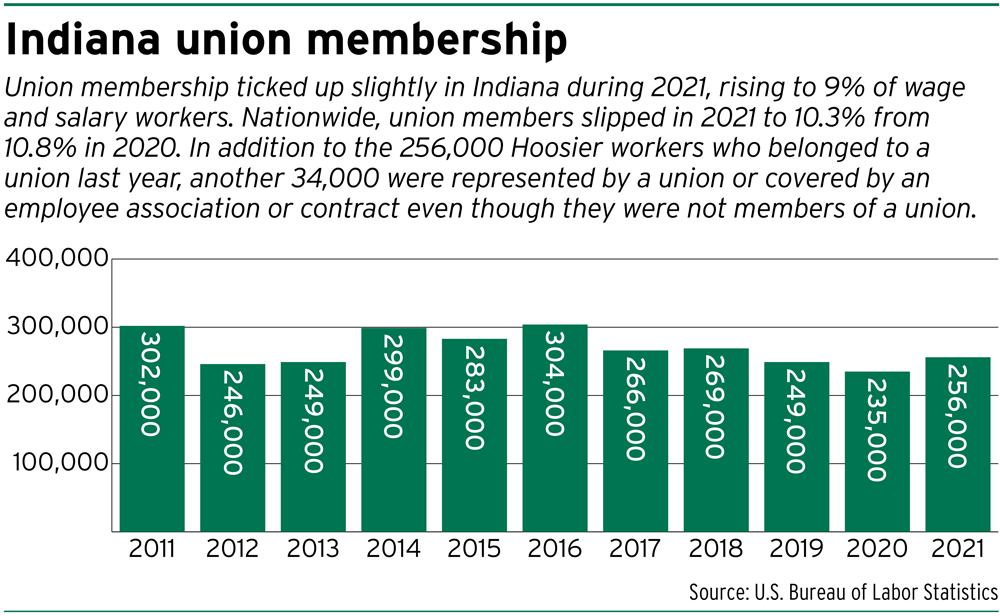Subscriber Benefit
As a subscriber you can listen to articles at work, in the car, or while you work out. Subscribe NowJust as Indiana is marking 10 years since the passage of its “right-to-work” law, more Hoosiers are opting to join unions, and a Starbucks in Clarksville recently became the first in the coffeehouse chain to unionize in the Hoosier State.
Union membership in Indiana reached 9% in 2021, up from 8.3% in 2020, according to the U.S. Bureau of Labor Statistics. Even with the uptick, Indiana is still far below its peak unionism of 21% in 1989, but the state saw an increase last year while national union membership dipped to 10.3% from 10.8%.
Labor and employment attorneys point to the COVID-19 pandemic as a catalyst for the interest in workplace unionization. Americans have been disgruntled with stagnant wages and declining benefits for years, the attorneys say, but the coronavirus shifted the attitude of workers to think that low-wage jobs were no longer worth the effort.

As a result, workers saw advantages to organizing and became less afraid of the risk of losing their jobs, said Indiana University Maurer School of Law employment and labor law professor Kenneth Dau-Schmidt. They look at collective bargaining as not only a way to get higher wages but also to fix scheduling problems and offer health insurance. More importantly, especially for younger workers, is the possibility of having a voice.
“They look at it and say, ‘If we organize, we can get more of what we want, we can get a voice in the running of the firm and I’m not afraid that they’re going to fire me for organizing,’” Dau-Schmidt said.
Indiana enacted its “right-to-work” law in 2012, becoming the 23rd state to do so. Except for a legal challenge — Zoeller, et al. v. Sweeney, et al., 45S00-1309-PL-596 — that resulted in the Indiana Supreme Court finding the statute constitutional in 2014, the law has stood untouched.
Patrick Semmens, vice president of the National Right to Work Legal Defense Foundation, highlighted data that indicate the unionization picture in Indiana is more complicated.

For the past 12-month period, 21 union certification petitions were filed with workers asking for a vote on joining a union while, at the same time, nine decertification petitions were submitted as workers were looking to get rid of the representation. The number of employees involved was nearly equal, with more than 200 asking for decertification votes and just over 300 seeking certification elections.
“If you look at those numbers, and then take the 9% unionization rate, what you would find is that a currently unionized worker is more likely to be involved in holding a vote to get rid of their union than the currently nonunionized worker is to be involved in a vote to bring a union in,” Semmens said.
Permanent or temporary?
Whether the trend to organizing continues to climb will depend on what happens next in the workplaces that have voted for union representation.
Barnes & Thornburg employment and labor law attorney David Pryzbylski explained a new union and employer can take longer to bargain that first contract. The parties are starting from scratch, trying to determine what their relationship will entail going forward.Particularly in companies that have multiple locations across the country, like Amazon, workers will be watching to see what that contract brings to the facility that unionized. The contents of the agreement will likely be the primary motivator for other workers as they decide either to support or forgo organizing.

“If there’s a labor agreement that’s reached and the wages aren’t more favorable, the benefits aren’t more favorable, employees might look at that and say, ‘Look, do we want to do the long and arduous process of going through a union campaign? Doesn’t look like it’s going to add that much value to us,’” Pryzbylski said.
Dau-Schmidt said collective bargaining agreements could go beyond pay and scheduling to also address some contentious legal issues. Currently, mandatory arbitration, especially without class representation and noncompete clauses, are drawing a lot of attention and, he said, are seen as unfair to workers and as creating a drag on the economy.
“These are issues in employment law that are becoming a big enough issue for employees that they could help with union organizing or they certainly would be something that unions might want to bargain over,” Dau-Schmidt said.
Changes in the workplace
The picture of baristas and e-commerce clerks who tend to change workplaces frequently as union members jars a bit with the traditional image of union workers laboring in manufacturing plants for years. However, David Vlink, founder of Vlink Law Firm, said the union model applies to different workplaces and can even stabilize employee turnover.

“If employees are paid better and get better benefits, I think that turnover, there’s not going to be as much,” Vlink said. “… If it is a temporary job or a stepping stone to somewhere else, great. But you have a union for the time that you’re there so that you get paid and get benefits and time off and everything that you deserve while you’re there.”
What needs to be adjusted is the National Labor Relations Act, Vlink said. Namely, the federal law should have some teeth to chomp employers who intimidate, threaten and penalize workers to discourage unionization, he said.
Vlink suggested that elections for establishing a union should only have to be held if the employer has a “good faith and reason” to doubt the workers’ petition requesting union representation. Also, he said he supports ending the so-called “captive audience meetings,” in which an employer will gather the employees together, then discourage them from organizing by insinuating such things as the facility closing if a union comes in.
The main problem with enforcement, he continued, is the time it takes. As an example, he noted companies often stop unionization efforts by firing the worker who is leading the organizing.
 “When that happens, if you can prove it, (the National Labor Relations Board) will pursue a case against an employer but … the damage to the organizing effort has already been done,” Vlink said. “And the damage to the employee, it could get rectified, but it takes years. I wish it could be done a little bit faster.”
“When that happens, if you can prove it, (the National Labor Relations Board) will pursue a case against an employer but … the damage to the organizing effort has already been done,” Vlink said. “And the damage to the employee, it could get rectified, but it takes years. I wish it could be done a little bit faster.”
Semmens countered by arguing for the passage of the National Right to Work Act. He described right-to-work as supporting “voluntary unionism” by allowing workers to choose to support the union without worrying about losing their jobs if they do not.
“I think the other thing that’s a positive for right-to-work is when there is a union in place, it gives workers a way to hold union officials accountable,” Semmens said, explaining that if employees are unhappy with the labor agreement, they can show their discontent by withholding their dues. “And that should — in theory, it doesn’t always — create incentives for union officials to be more responsive.”
Meanwhile, employers are taking steps to create workplaces where employees are satisfied and do not feel a need to unionize, according to Pryzbylski. Compensation packages are being reevaluated along with the more ethereal things that make a warehouse, coffee shop or office attractive to workers.
“By and large what’s going to keep people are people who are happy coming to work, enjoying the people they work with and feeling respected and appreciated,” Pryzbylski said. “So I’m seeing a big focus on strengthening company culture and employee relations.”•
Please enable JavaScript to view this content.

